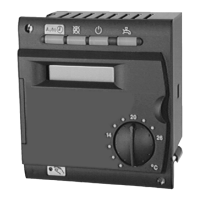81/166
Siemens Building Technologies Basic Documentation RVA47.320 CE1P2379E
HVAC Products Description of the heating engineer settings 15.07.2002
4.33 Adaption of the heating curve
• No heating curve adjustments required
• Automatic adaption of heating curve
The adaption facility learns from the different heating situations and matches the control
to the heating circuit at regular intervals. Also refer to section ”Adaption sensitivities”
(lines 36
OEM
+ 37
OEM
).
1. Press the operating line selection buttons to select operating line 106.
2. Press the + / – buttons to select the type of heating curve adaption.
Setting range Unit Factory setting
0 / 1 Increment 1
The setting will switch automatic adaption of the heating curve on or off.
Entry:
0 Automatic adaption inactive: The heating curve will use the setting made
1 Automatic adaption active: In automatic mode (nominal room temperature
setpoint
), the heating curve will automatically and continuously be adapted
Prerequisite is the presence of a room temperature sensor.
The adaption facility automatically matches the heating curve to the type of building
construction and the heating requirements. Adaption gives consideration to room
temperature deviations, outside temperature characteristics and adaption sensitivity.
To achieve optimum adaption, the following situations should occur as rarely as
possible - especially after commissioning - since this would reset certain calculations
required for the adaption:
− Manual correction of heating curve
− Power failure
− Heating curve set to --.-
− Changes to the room temperature setpoint
Every day at midnight, the room temperature control differential of the previous day is
evaluated. This evaluation leads to an automatic readjustment of the heating curve.
• Simple adaption (range
):
At attenuated outside temperatures below 4 °C, it is only the slope of the heating
curve that is adapted.
Within this temperature range, the readjustment is weighted with the factor f2 and
adaption sensitivity 2 (line 37
OEM).
• Combined adaption (range
):
At attenuated outside temperatures of between 4 and 12 °C, it is partly the slope
and partly the parallel displacement that are adapted.
Within this temperature range, the readjustment of the parallel displacement is
weighted with the factor f1 and adaption sensitivity 1 (line 36
OEM).
Benefit
Description
Setting
Effect
Note
Adaption
Note
Process

